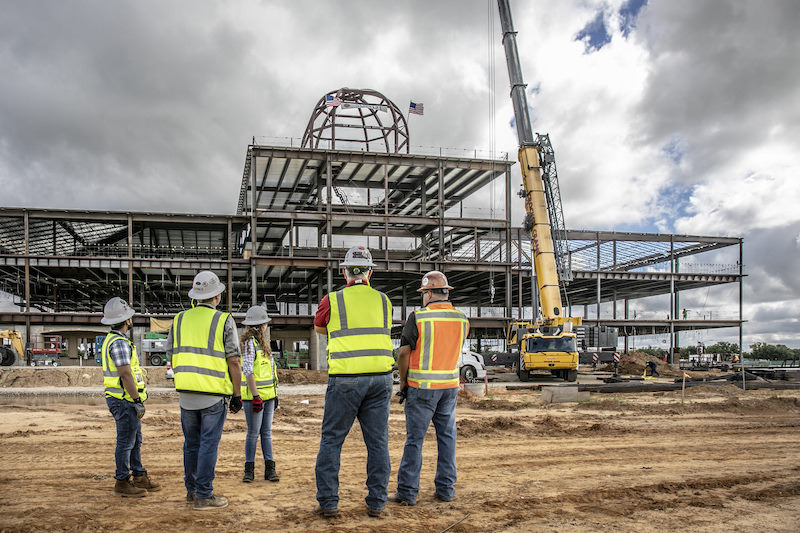The construction industry lost 3,000 jobs between July and August as ongoing declines in nonresidential segments offset a pickup among residential building and remodeling firms, according to an analysis by the Associated General Contractors of America of government data released today. Association officials said their newly released survey shows many contractors are eager to hire but are encountering a lack of qualified applicants and supply-chain delays that are holding back nonresidential employment gains.
“Today’s figures show that nonresidential building and infrastructure contractors are having a hard time recovering from the impact of the pandemic on demand for structures,” said Ken Simonson, the association’s chief economist. “At the same time, our survey finds many contractors have job openings but are experiencing a lack of qualified applicants, shortages of materials and long delivery delays.”
Construction employment in August totaled 7,416,000, a drop of 3,000 from July. Employment among nonresidential firms—comprising heavy and civil engineering construction firms, along with nonresidential building and specialty trade contractors—shrank for the fifth month in a row, by 20,300. In contrast, homebuilders and residential specialty trade contractors added 17,400 workers, the fourth-straight gain.
Despite the job losses for nonresidential construction firms, the association’s annual workforce survey, conducted with Autodesk, found many of its members—nonresidential and multifamily contractors—have unfilled job openings. Ninety percent of the more than 2,100 firms that responded had openings for hourly craft workers, while 62% had openings for salaried employees. Overwhelming percentages of firms with openings reported having a hard time filling positions, including 89% of the companies seeking craft workers and 86% of those looking for salaried employees.
Contractors are facing multiple challenges. Seventy-two percent of survey respondents reported that available job candidates were not qualified. Three-quarters of the firms reported projects were delayed due to longer lead times or shortages of materials, while 57% reported delivery delays.
Association officials called on officials in Washington to address both immediate and long-term needs for the construction industry. They urged lawmakers to finish work on the Senate-passed infrastructure bill and provide more funding for career and technical education programs that will attract and prepare more people for high-paying careers in construction.
“Contractors are eager to hire more workers but they need Washington officials to make sure there is enough funding for vitally needed infrastructure to justify hiring,” said Stephen E. Sandherr, the association’s chief executive officer. “In addition, more federal money should be going into preparing workers to execute these projects.”
Click here for the association’s survey results.
Related Stories
Market Data | Mar 29, 2017
Contractor confidence ends 2016 down but still in positive territory
Although all three diffusion indices in the survey fell by more than five points they remain well above the threshold of 50, which signals that construction activity will continue to be one of the few significant drivers of economic growth.
Market Data | Mar 24, 2017
These are the most and least innovative states for 2017
Connecticut, Virginia, and Maryland are all in the top 10 most innovative states, but none of them were able to claim the number one spot.
Market Data | Mar 22, 2017
After a strong year, construction industry anxious about Washington’s proposed policy shifts
Impacts on labor and materials costs at issue, according to latest JLL report.
Market Data | Mar 22, 2017
Architecture Billings Index rebounds into positive territory
Business conditions projected to solidify moving into the spring and summer.
Market Data | Mar 15, 2017
ABC's Construction Backlog Indicator fell to end 2016
Contractors in each segment surveyed all saw lower backlog during the fourth quarter, with firms in the heavy industrial segment experiencing the largest drop.
Market Data | Feb 28, 2017
Leopardo’s 2017 Construction Economics Report shows year-over-year construction spending increase of 4.2%
The pace of growth was slower than in 2015, however.
Market Data | Feb 23, 2017
Entering 2017, architecture billings slip modestly
Despite minor slowdown in overall billings, commercial/ industrial and institutional sectors post strongest gains in over 12 months.
Market Data | Feb 16, 2017
How does your hospital stack up? Grumman/Butkus Associates 2016 Hospital Benchmarking Survey
Report examines electricity, fossil fuel, water/sewer, and carbon footprint.
Market Data | Feb 1, 2017
Nonresidential spending falters slightly to end 2016
Nonresidential spending decreased from $713.1 billion in November to $708.2 billion in December.
Market Data | Jan 31, 2017
AIA foresees nonres building spending increasing, but at a slower pace than in 2016
Expects another double-digit growth year for office construction, but a more modest uptick for health-related building.

















